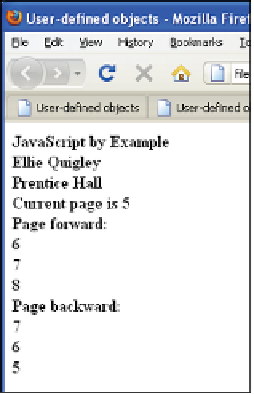HTML and CSS Reference
In-Depth Information
EXPLANATION
(
CONTINUED
)
4
The property
this.backpage
is assigned the name of the function,
pageBackward
,
that will serve as the object's method.
5
The function
pageForward()
is defined. Its purpose is to increase the page number
of the topic by
one
, and return the new page number.
6
The function
pageBackward()
is defined. Its purpose is to decrease the page num-
ber by
one
and return the new page number.
7
A new object called
myBook
is created. The
new
operator invokes the
Book()
con-
structor function with three arguments: the title of the topic, the author, and the
publisher.
8
The
pagenumber
property is set to
5
.
9
The properties of the object are displayed in the browser window.
10
The
for
loop is entered. It will loop three times.
11
The
uppage()
method is called for the
myBook
object. It will increase the page
number by 1 and display the new value, each time through the for loop.
12
The
backpage()
method is called for the
myBook
object. It will decrease the page
number by 1 and display the new value each time through the loop. The output
is shown in Figure 8.6.
Figure 8.6
An instance of the Book class, its properties, and methods.
Rather than naming a function outside the class, an inline or anonymous function can
be assigned directly to a property within the constructor function. (Every instance of the




